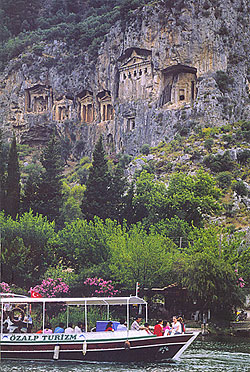 Kaunos
Kaunos
The ancient city of Caunos stands midway along the channel facing Dalyan. Settlement here is believed to date from 3000 BC by Caunos, the son of Miletos and it later grew into a major port on the border between Lycia and Caria. Sprawling over a broad sloping site overlooking the sea and the delta, the principal monuments to be seen in Caunos are the Acropolis surrounded by city walls, a theatre, four temples, an agora, stoa, nymphain, baths, palestra, churches and a cistern.
The imposing Lycian rock tombs with their facades curved into the form of temples were the last resting place of the kings of Caunos. The city had two harbours, one for military use and the other for merchants. Inscriptions discovered on the nymphain have been found to cite customs regulations and have thrown valuable light on the economic life of the city. The Lycians developed this form of art to perfection, no doubt facilitated by the soft limestone of the region.
The quality of stonemasonry of the Lycian people is noteworthy and is especially significant in the construction of tombs. Today the entire landscape of Lycia is still dotted with their fascinating funerary monuments.
The most recent count has revealed one thousand and eighty-five examples still intact, rock-cut tombs being the most common form. Lycia is famous for the sheer number of tombs and their quality.
One thing that sets Lycian tombs apart from Hellenistic tradition is that whereas in Hellenistic culture the dead were placed outside of liveable areas (often flanking main roads into the cities), Lycian tombs are integrated often integrated right into cities, displaying Lycia's ties with eastern traditions.
The Lycians seem to have held a belief that the souls of their dead would be transported from the tombs to the afterworld by a sort of winged siren-like creature, and so often placed their tombs along the coast or at the top of cliffs when they were not integrated into the liveable areas of the cities.
Kaunos (Caunus) is perhaps one of the most spellbinding of ancient cities for its landscape as well as its history with roots in the remote past. Situated in a mysterious landscape formed by the Dalyan river (Calbis), which connects Lake Koycegiz with the Mediterranean, the Dalyan delta and Mt. Olemez (Imbros). And the astonishing findings that are being recovered almost every year in the archaeological excavations that have been under way here since 1966 are generating increasingly more unknowns out of the city's stony silence.
The story of Kaunos's eponymous founder as related by the Roman poet Ovid is helpful in acquainting us with this mysterious city like a quiet stranger with a secret. Kaunos, the son of Apollo's son Miletos and the water nymph Kyanee, was in love with his twin sister Byblis. Running away from home in an attempt to flee this extraordinary yet illicit passion, he founds a city in a faraway place.
Byblis meanwhile sets out in search of her twin brother and is transformed into a spring by water nymphs while she lies stretched out prone on the earth in tears of desperation and exhaustion. Another source of detailed information about the natives of Kaunos is the ancient historian Herodotus, who lived in the 5th century B.C. We can conclude from his account that Kaunos was the capital of the region between Caria and Lycia, which was home to several cities. According to Herodotus, the natives of Kaunos, who believed they came from Crete like the Lycians and Carians, were actually an Anatolian people. Moreover, their language, which was entirely unique to them, had in all probability influenced that of Caria.







